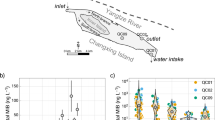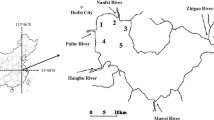Abstract
Taste and odor episodes caused by off-flavor secondary metabolites, such as 2-methylisoborneol (MIB) and geosmin, pose one of the greatest challenges for drinking water utilities around the world. The prevalence of these compounds is predicted to increase in the future as a function of nutrient enrichment and elevated temperatures of surface drinking water sources. We conducted a manipulative field experiment in a drinking water reservoir to elucidate patterns for two taste and odor compounds, MIB and geosmin, as well as two taxa known to produce these compounds, phytoplankton (more specifically, cyanobacteria) and actinobacteria, across different depths in response to nutrient enrichment with two common dissolved nitrogen forms, organic urea or inorganic nitrate. In general, we found that MIB levels increased by greater than 250% with nutrient enrichment mediated by increased phytoplankton biomass. However, the effect of the fertilization treatments on MIB decreased with depth with a 35% reduction at 7 m versus 1.5 m. In contrast, geosmin levels reached a maximum at the lowest measured depth (7 m), were unaffected by the fertilization treatments, and followed a similar pattern to the abundance of actinobacteria. Thus, our data suggest that the positive response of phytoplankton (e.g., cyanobacteria, such as Oscillatoria species) to the fertilization treatments is likely responsible for increased MIB, while geosmin concentrations may be a function of actinobacteria-mediated decomposition in the hypolimnion in our study system.



Similar content being viewed by others
Data availability
The datasets used and/or analyzed during the current study are available from the corresponding author on reasonable request.
References
Allgaier M, Grossart HP. (2006) Diversity and seasonal dynamics of actinobacteria populations in four lakes in northeastern Germany. Applied and Environmental Microbiology 72(5):3489-3497. https://doi.org/10.1128/AEM.72.5.3489-3497.2006
American Public Health Association. (2012) Standard methods for examination of water and wastewater: 6040 D. Solid-phase Microextraction (SPME), 22nd ed. Washington (DC).
American Public Health Association, American Water Works Association, and Water Environment Federation. (1999) Standard methods for examination of water and wastewater: 9250 Detection of Actinomycetes, 20th ed. Washington (DC).
American Water Works Association. (2004) Actinomycetes. In: Christensen M, and Stearns C, editors. Problems Organisms in Water: Identification and Treatment. 3rd ed. Denver (CO). pp. 1-5.
Anuar NSS, Kassim AA, Utsumi M, Iwamoto K, Goto M, Shimizu K, Othman N, Zakaria Z, Sugiura N, Hara H (2017) Characterization of musty odor-producing actinomycetes from tropics and effects of temperature on the production of musty odor compounds. Microbes Environ 32(4):352–357. https://doi.org/10.1264/jsme2.ME17109
Barton K. (2015) MuMIn: multi-model inference. R package version 1.15.1. https://rdrr.io/cran/MuMIn/man/MuMIn-package.html.
Bates D, Maechler M, Bolker B, Walker S (2015) Fitting linear mixed-effects models using lme4. J Stat Softw 67:1–48. https://doi.org/10.18637/jss.vo67.i01
Cai FF, Yu GL, Zhang K, Chen YX, Li Q, Yang YM, Xie JL, Wang YL, Li RH (2017) Geosmin production and polyphasic characterization of Oscillatoria limosa Agardh ex Gomont isolated from the open canal of a large drinking water system in Tianjin City, China. Harmful Algae 69:28–37. https://doi.org/10.1016/j.hal.2017.09.006
Chislock MF (2015) Ecology and management of off flavors and cyanotoxins. Lakeline Winter 2015:43–46 http://z0ku333mvy924cayk1kta4r1-wpengine.netdna-ssl.com/wp-content/uploads/LakeLine/35-4/Articles/35-4-14.pdf
Clercin NA, Druschel GK (2019) Influence of environmental factors on the production of MIB and geosmin metabolites by bacteria in a eutrophic reservoir. Water Resour Res 55(7):5413–5430. https://doi.org/10.1029/2018WR023651
Cook D, Newcombe G, Sztajnbok P (2001) The application of powdered activated carbon for MIB and geosmin removal: Predicting PAC doses in four raw waters. Water Res 35(5):1325–1333. https://doi.org/10.1016/S0043-1354(00)00363-8
Deng XW, Qi M, Ren R, Liu JR, Sun XX, Xie P, Chen J (2019) The relationships between odors and environmental factors at bloom and non-bloom area in Lake Taihu, China. Chemosphere 218:569–576. https://doi.org/10.1016/j.chemosphere.2018.11.121
Durrer M, Zimmermann U, Juttner F (1999) Dissolved and particle-bound geosmin in a mesotrophic lake (Lake Zurich): spatial and seasonal distribution and the effect of grazers. Water Res 33(17):3628–3636. https://doi.org/10.1016/S0043-1354(99)00069-X
Francy DS, Bushon RN, Brady AMG, Kephart CM, Stelzer EA, Ecker CD. (2014) Appendix C14: Detection of actinomycetes in water. Quality Assurance/Quality Control Manual: USGS Ohio Water Microbiology Laboratory. https://oh.water.usgs.gov/OWML/micro_qaqc_actinomycetes.htm. Accessed January 2015.
Gao JS, Zhu J, Wang MW, Dong WY (2018) Dominance and growth factors of Pseudanabaena sp in drinking water source reservoirs, southern China. Sustainability 10(11):3936. https://doi.org/10.3390/su10113936
Graham JL, Loftin KA, Meyer MT, Ziegler AC (2010) Cyanotoxin mixtures and taste-and-odor compounds in cyanobacterial blooms from the midwestern United States. Environ Sci Technol 44(19):7361–7368. https://doi.org/10.1021/es1008938
Halstvedt CB, Rohrlack T, Andersen T, Skulberg O, Edvardsen B (2007) Seasonal dynamics and depth distribution of Planktothrix spp. in Lake Steinsfjorden (Norway) related to environmental factors. J Plankton Res 29(5):471–482. https://doi.org/10.1093/plankt/fbm036
Harris TD, Smith VH, Graham JL, Van de Waal DB, Tedesco LP, Clercin N (2016) Combined effects of nitrogen to phosphorus and nitrate to ammonia ratios on cyanobacterial metabolite concentrations in eutrophic Midwestern USA reservoirs. Inland Waters 6(2):199–210. https://doi.org/10.5268/IW-6.2.938
Izaguirre G, Taylor WD (2007) Geosmin and MIB events in a new reservoir in southern California. Water Sci Technol 55(5):9–14. https://doi.org/10.2166/wst.2007.156
Jia ZY, Su M, Liu TT, Guo QY, Wang Q, Burch M, Yu JW, Yang M (2019) Light as a possible regulator of MIB-producing Planktothrix in source water reservoir, mechanism and in-situ verification. Harmful Algae 88:101658. https://doi.org/10.1016/j.hal.2019.101658
Jüttner F, Watson SB (2007) Biochemical and ecological control of geosmin and 2-methylisoborneol in source waters. Appl Environ Microbiol 73:4395–4406. https://doi.org/10.1128/AEM.02250-06
Knoll LB, Sarnelle O, Hamilton SK, Kissman CEH, Wilson AE, Rose JB, Morgan MR (2008) Invasive zebra mussels (Dreissena polymorpha) increase cyanobacterial toxin concentrations in low-nutrient lakes. Can J Fish Aquat Sci 65(3):448–455. https://doi.org/10.1139/f07-181
Kutovaya OA, Watson SB (2014) Development and application of a molecular assay to detect and monitor geosmin-producing cyanobacteria and actinomycetes in the Great Lakes. J Great Lakes Res 40(2):404–414. https://doi.org/10.1016/j.jglr.2014.03.016
Nakagawa S, Schielzeth H (2013) A general and simple method for obtaining R2 from generalized linear mixed-effects models. Methods Ecol Evol 4:133–142. https://doi.org/10.1111/j.2041-210x.2012.00261.x
Olsen BK, Chislock MF, Wilson AE (2016) Eutrophication mediates a common off- flavor compound, 2-methylisoborneol, in a drinking water reservoir. Water Res 92:228–234. https://doi.org/10.1016/j.watres.2016.01.058
Olsen BK, Chislock MF, Rebelein A, Wilson AE (2017) Nutrient enrichment and vertical mixing mediate 2-methylisoborneol and geosmin concentrations in a drinking water reservoir. Water Sci Technol Water Supply 17:500–507. https://doi.org/10.2166/ws.2016.159
Otten TG, Graham JL, Harris TD, Dreher TW (2016) Elucidation of taste- and odor-producing bacteria and toxigenic cyanobacteria in a midwestern drinking water supply reservoir by shotgun metagenomic analysis. Appl Environ Microbiol 82(17):5410–5420. https://doi.org/10.1128/AEM.01334-16
Pinheiro J, Bates D, DebRoy S, Sarkar D, R Core Team. (2015) nlme: Linear and nonlinear mixed effects models. R package version 3.1-121, URL: http://CRAN.R-project.org/package=nlme
Qi C, Fang JQ, Wang GX, Huang HX, Wang ZS, Si ZJ, Zhang LM (2020) Characterization of odorants in contrasting ecotypes of Lake Taihu: algae-dominated versus macrophyte-dominated zones. Environ Sci Pollut Res 27:42221–42229. https://doi.org/10.1007/s11356-020-07896-0
Schrader KK, Davidson JW, Summerfelt ST (2013) Evaluation of the impact of nitrate-nitrogen levels in recirculating aquaculture systems on concentrations of the off-flavor compounds geosmin and 2-methylisoborneol in water and rainbow trout (Oncorhynchus mykiss). Aquac Eng 57:126–130. https://doi.org/10.1016/j.aquaeng.2013.07.002
Schrader KK, Green BW, Perschbacher PW (2011) Development of phytoplankton communities and common off-flavors in a biofloc technology system used for the culture of channel catfish (Ictalurus punctatus). Aquac Eng 45(3):118–126. https://doi.org/10.1016/j.aquaeng.2011.08.004
Shen QY, Shimizu K, Miao HC, Tsukino S, Utsumi M, Lei ZF, Zhang ZY, Nishimura O, Asada Y, Fujimoto N, Takanashi H, Akiba M (2020) Effects of elevated nitrogen on the growth and geosmin productivity of Dolichospermum smithii. Environ Sci Pollut Res 28:177–184. https://doi.org/10.1007/s11356-020-10429-4
Su M, Jia DM, Yu JW, Vogt RD, Wang JS, An W, Yang M (2017) Reducing production of taste and odor by deep-living cyanobacteria in drinking water reservoirs by regulation of water level. Sci Total Environ 574:1477–1483. https://doi.org/10.1016/j.scitotenv.2016.08.134
Su M, Yu JW, Zhang JZ, Chen H, An W, Vogt RD, Andersen T, Jia DM, Wang JS, Yang M (2015) MIB-producing cyanobacteria (Planktothrix sp.) in a drinking water reservoir: Distribution and odor producing potential. Water Res 68:444–453. https://doi.org/10.1016/j.watres.2014.09.038
Sugiura N, Iwami N, Inamori Y, Nishimura O, Sudo R (1998) Significance of attached cyanobacteria relevant to the occurrence of musty odor in Lake Kasumigaura. Water Res 32(12):3549–3554. https://doi.org/10.1016/S0043-1354(98)00153-5
Suurnakki S, Gomez-Saez GV, Rantala-Ylinen A, Jokela J, Fewer DP, Sivonen K (2015) Identification of geosmin and 2-methylisoborneol in cyanobacteria and molecular detection methods for the producers of these compounds. Water Res 68:56–66. https://doi.org/10.1016/j.watres.2014.09.037
United States Department of Agriculture. (2019) USDA ERS - Summary of findings. https://www.ers.usda.gov/data-products/fertilizer-use-and-price/summary-of-findings/ (accessed 8 July 2020).
Vaida F, Fitzgerald A, DeGruttola V (2007) Efficient hybrid EM for non-linear mixed effects models with censored response. Computational Statistics and Data Analysis 51:5718–5730. https://doi.org/10.1016%2Fj.csda.2006.09.036
Watson SB (2003) Cyanobacterial and eukaryotic algal odour compounds: signals or by-products? A review of their biological activity. Phycologia 42(4):332–350. https://doi.org/10.2216/i0031-8884-42-4-332.1
Watson SB, Monis P, Baker P, Giglio S (2016) Biochemistry and genetics of taste- and odor-producing cyanobacteria. Harmful Algae 54:112–127. https://doi.org/10.1016/j.hal.2015.11.008
Wnorowski AU (1992) Tastes and odors in the aquatic environment - a review. Water SA 18(3):203–214 https://hdl.handle.net/10520/AJA03784738_1088
Wood S, Williams ST, White WR (1985) Potential sites of geosmin production by Streptomycetes in and around reservoirs. J Appl Bacteriol 58(3):319–326. https://doi.org/10.1111/j.1365-2672.1985.tb01467.x
Zhang JZ, Li LW, Qiu LJ, Wang XT, Meng XY, You Y, Yu JW, Ma WL (2017) Effects of climate change on 2-methylisoborneol production in two cyanobacterial species. Water 9(11):859. https://doi.org/10.3390/w9110859
Zwart G, Crump BC, Agterveld M, Hagen F, Han SK (2002) Typical freshwater bacteria: an analysis of available 16S rRNA gene sequences from plankton of lakes and rivers. Aquat Microb Ecol 28(2):141–155 https://www.int-res.com/articles/ame2002/28/a028p141.pdf
Acknowledgements
We thank William Thornton and Dan Hilyer for providing equipment and logistical support. We would also like to thank Rebecca Tucker for assistance with sampling and laboratory analyses. We thank Sushil Adhikari, Zhouhong Wang, Ken Mendenhall, and Amy Gamble-Coker for helping with GC/MS method development and Yifen Wang for use of lab space. Finally, we thank Matt Gladfelter, Angelea Belfiore, Riley Buley, and anonymous reviewers for feedback on earlier versions of this manuscript.
Funding
This study was supported by an EPA STAR Graduate Fellowship, USGS grant 2011AL121G, the Alabama Agricultural Experiment Station, and the Hatch program of the National Institute of Food and Agriculture, U.S. Department of Agriculture.
Author information
Authors and Affiliations
Contributions
Conceptualization: MFC, BKO, and AEW. Methodology: MFC, BKO, and AEW. Analyses: MFC, BKO, JC, AA, and AEW. Writing—original draft preparation: MFC, BKO, and AEW. Writing—review and editing: MFC, BKO, JC, AA, TLB, and AEW. Funding acquisition: MFC and AEW.
Corresponding author
Ethics declarations
Ethics approval and consent to participate
This research followed the guidelines provided by Auburn University for ethical research. Consent to participate was not applicable for this study.
Consent for publication
N/A
Competing interests
The authors declare that they have no competing interests.
Additional information
Responsible Editor: Diane Purchase
Publisher’s note
Springer Nature remains neutral with regard to jurisdictional claims in published maps and institutional affiliations.
Supplementary Information
ESM 1
(PPTX 462 kb)
Rights and permissions
About this article
Cite this article
Chislock, M.F., Olsen, B.K., Choi, J. et al. Contrasting patterns of 2-methylisoborneol (MIB) vs. geosmin across depth in a drinking water reservoir are mediated by cyanobacteria and actinobacteria. Environ Sci Pollut Res 28, 32005–32014 (2021). https://doi.org/10.1007/s11356-021-12973-z
Received:
Accepted:
Published:
Issue Date:
DOI: https://doi.org/10.1007/s11356-021-12973-z




